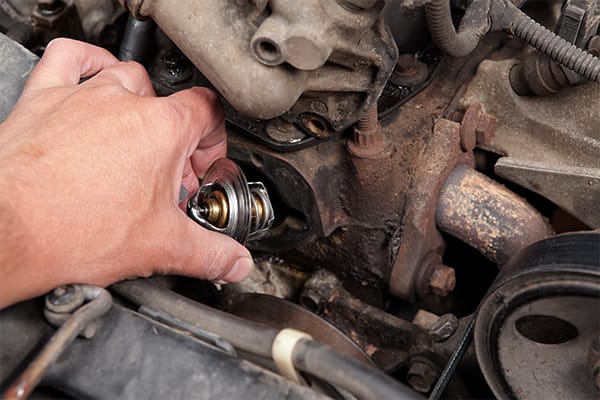Your car’s thermostat may appear to be a minor component, but it has a significant impact on how well your engine runs on a daily basis. It regulates the flow of coolant between the engine and the radiator, thereby helping to regulate the internal temperature of your vehicle. When it works properly, your engine maintains an optimal temperature, is efficient, and avoids overheating. However, when the thermostat fails, your car’s performance begins to suffer—and not always in the ways you would expect.
A faulty thermostat can quietly creep up on you. Sometimes it sticks open, and sometimes it won’t open at all. Either way, the consequences can range from increased fuel consumption to serious engine damage. So, let’s go over the most common signs that your thermostat may be failing, how it works, and how much it will cost to repair it, because catching it early can save you a lot of money and stress later.
Engine overheating: a classic red flag
When your thermostat is stuck in the closed position, coolant cannot circulate from the engine into the radiator. This means that the hot fluid remains trapped inside the engine, gradually increasing the temperature to dangerous levels. Because the heat is not being released through the radiator, it accumulates quickly, and your dashboard temperature gauge may spike before you have time to react. This type of overheating can cause serious damage, such as a blown head gasket or a warped cylinder head, which requires costly and time-consuming repairs.
A stuck thermostat is one of the most common causes of engine overheating, although other factors such as a failed water pump or low coolant levels can also contribute. When diagnosing the problem, it is critical to check all cooling system components, but the thermostat should be at the top of your list. If your engine is consistently overheating, don’t put off having it checked—it’s not a warning you can afford to ignore.
Engine will not reach or maintain normal operating temperature
If your engine never seems to warm up, it could be because your thermostat is stuck in the open position. In this case, coolant continues to flow through the engine even when it is not required, preventing the engine from reaching the proper operating temperature. A cooler engine may appear to be beneficial, but it actually leads to poor fuel combustion and sluggish performance.
You will probably notice that your cars for sale in Thailand is burning more fuel than usual and possibly running rougher in colder weather. The engine may take a long time to warm up, or it may never start at all. In the long run, running an engine at too low a temperature can wear out internal parts and prematurely age critical components. This kind of inefficiency is a silent money drain that accumulates with each mile.
Temperature gauge starts fluctuating without reason
When the temperature gauge on your dashboard begins to behave erratically, that is one of the more subtle signs of a failing thermostat. It may alternate between normal and hot, or it may bounce up and down while driving. This occurs when the thermostat does not open and close at the appropriate times—it may stick halfway or open randomly, resulting in inconsistent coolant flow and unstable engine temperatures.
These fluctuations make it difficult to determine whether your engine is actually overheating or if the gauge is simply displaying a glitch. But it’s rarely a coincidence. When temperature readings are all over the place and no other obvious problem exists, the thermostat is most likely sending mixed signals to your cooling system. The sooner you address it, the better—because engine temperature fluctuations can cause even more wear on internal components over time.
The heating system blows both hot and cold
If your car’s heater suddenly starts acting confused—blowing hot air one minute and cold the next—it’s a good indication that the thermostat isn’t working properly. To produce warm air, the car’s heater uses engine coolant. When the thermostat fails to properly regulate the coolant, uneven heating occurs inside the cabin. This is especially noticeable during the colder months, when you rely on consistent heat while driving.
So, if your heat intermittently turns on and off and you are seeing strange temperature readings, the thermostat is most likely failing. And, while it may appear to be a comfort issue at first, keep in mind that it is another symptom of an unstable cooling system, and it often indicates that your engine is also affected.
Leaks, steam, or an enlarged expansion tank
When a thermostat fails, pressure accumulates in the cooling system because it prevents the flow of hot coolant. Eventually, this pressure causes coolant to escape through the weakest point—perhaps a cracked radiator cap, a hose joint, or even the coolant reservoir. If you see white steam coming from under the hood or visible coolant leaks, don’t dismiss them. A stuck thermostat may be causing the system to vent excessive heat and pressure.
In some cases, the expansion tank may become overfilled with hot coolant because it has nowhere else to go. If the coolant is bubbling and the temperature gauge continues to rise, you should immediately stop the car and inspect the situation. These are obvious signs of overheating, and the thermostat could very well be the culprit.
How Does a Car Thermostat Work?
The thermostat’s purpose is to regulate coolant flow based on engine temperature. When the engine is cold, the thermostat remains closed, allowing the coolant to stay inside the engine and heat up more quickly. As the temperature rises to the ideal operating range, usually between 195 and 220°F, the thermostat opens, allowing coolant to flow into the radiator and be cooled. It then cycles back into the engine, repeating the process until everything runs smoothly.
In other words, the thermostat functions as a temperature-controlled gatekeeper. It constantly adjusts coolant flow based on the engine’s temperature. This regulation is necessary not only for performance but also to prevent damage caused by overheating or cold starts. A malfunctioning thermostat completely disrupts this balance, which is why it should be addressed as soon as symptoms appear.
Where Is the Thermostat in Your Car?
Most cars have a thermostat inside a housing that connects to either the upper or lower radiator hose, often near the water pump. Because it is tucked into this housing, it is rarely visible until you begin disassembling some components under the hood. Some vehicles make it easy to find, while others bury it in tight engine compartments that require more effort to access.
If you are unsure about your car’s layout, a good repair manual can help you locate your thermostat. Just remember to let the engine cool before touching or removing anything near the cooling system.
How Much Does It Cost To Replace A Thermostat?
Thermostat replacement is not the most expensive repair, but the cost varies greatly depending on your vehicle. The average cost ranges between $70 and $450. The part itself typically costs between $20 and $50, but labor can significantly increase that cost, especially if the thermostat is difficult to reach or is part of a larger assembly.
Some modern vehicles have thermostats built into a housing or module that cannot be replaced separately, making the component more expensive. In these cases, the entire housing may need to be replaced. However, if you are mechanically inclined and your thermostat is in an easily accessible location, you may be able to do the job yourself with only a few tools.


